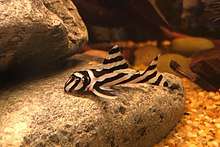Zebra pleco
The zebra pleco (Hypancistrus zebra) is a species of catfish endemic to Brazil where it occurs in the Big Bend area of the Xingu River, a tributary of the Amazon River, and was first described in the early 1990s.[1] It gets its name from its black and white stripes, resembling the colouration of a zebra. This species grows to a length of 6.4 centimetres (2.5 in) SL.[1] This fish was exported from Brazil in great numbers for sale as aquarium fish. However, currently the Brazilian government bans the export of certain Hypancistrus, including H. zebra.
| Zebra pleco | |
|---|---|
 | |
| Captive bred juvenile - Photo: M.Sykes | |
| Scientific classification | |
| Kingdom: | Animalia |
| Phylum: | Chordata |
| Class: | Actinopterygii |
| Order: | Siluriformes |
| Family: | Loricariidae |
| Genus: | Hypancistrus |
| Species: | H. zebra |
| Binomial name | |
| Hypancistrus zebra | |
H. zebra is threatened by the construction of the Belo Monte Dam in the Xingu river which will cause a severe reduction of the water flow of the entire known distribution range of the species. Due to this, the species has been classified as endangered and may soon become extinct in the wild. It is subject to several captive breeding programs.
Mature males have a larger head and longer interopercular spines than females. After spawning, the males will guard the eggs. The fry swim after seven days and absorb the yolk sac in two weeks.[2]
In the aquarium
Hypancistrus zebra is called L046,L098 in terms of the L-numbering convention often applied to Loricariidae. H. zebra is a predator and requires a high protein diet. Their diet should include small invertebrates such as chironomid-larva. It enjoys live, fresh and frozen bloodworm.
This species should not be kept in the typical community aquarium, or with discus fish, despite advice to the contrary. These catfish thrive in biotopes with small dither fish which do not compete for food.
The tank should mimic their natural environment with a substrate of small smooth gravel and pebbles with smooth boulders, cobbles and rocks forming caves and crevices.[3] The water must be highly oxygenated with a strong flow and surface agitation.
It is an expensive specimen, due to the fact it is rarely available. It is a hard fish to keep, as it needs clear water and a fast moving current. They are unable to survive in still water or dirty quarters.[2] It is nocturnal, moderately territorial, and prefers plenty of hiding places.[2]
In 2004 the Zebra Pleco was added to IBAMA list of endangered species and was made illegal to export from Brazil, although this law is only present in Brazil and certain black market fish traders will smuggle them out of Brazil to then sell on legally in other countries.
Breeding Behaviour
As per most pleco, the male will trap the female into a cave where she will lay her eggs for the male to fertilise this is usually done at around a pH of 6.5-7.2 and a water temp of 27°. This process can take between 1-5 days depending on the experience the female has in motherhood, the male will often bite the female to keep her in the cave, this is natural behaviour. Once the eggs are fertilised, the female will leave the male will guard the eggs until they hatch and may even stay for early fry stage. Once born, the fry will have a yolk sack attached to their underbelly, this should be gone in a few days.
References
- Froese, Rainer and Pauly, Daniel, eds. (2011). "Hypancistrus zebra" in FishBase. December 2011 version.
- Sanford, Gina (1999). Aquarium Owner's Guide. New York: DK Publishing. p. 40. ISBN 0-7894-4614-6.
- "Fish Keeper UK". Retrieved 22 April 2019.
External links
- http://www.brianstropicals.com/pages/Zebra-plecos.html - export ban
- http://www.zebrapleco.com/ - a web-site dedicated to zebra pleco husbandry and breeding
| Wikimedia Commons has media related to Hypancistrus zebra. |